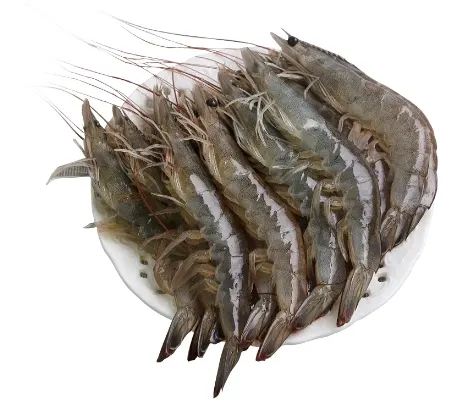يشيع استخدام ترايبوليفوسفات الصوديوم (STPP) في الجمبري المجمد والمأكولات البحرية الأخرى للاحتفاظ بالرطوبة وتحسين القوام. ولكن هل هو آمن للاستهلاك؟ في هذه المقالة، سنستكشف ما هو STPP، وسبب إضافته إلى الروبيان، وما إذا كان يجب أن تقلق بشأنه في المأكولات البحرية. في النهاية، سيكون لديك فهم واضح لكيفية تأثير STPP على الروبيان وما إذا كان يجب عليك الابتعاد عنه في عملية الشراء القادمة للمأكولات البحرية.
1. ما هو ثلاثي فوسفات الصوديوم (STPP) ولماذا يستخدم في الروبيان؟
تريبوليفوسفات الصوديوم (STPP) هو مركب كيميائي يستخدم في العديد من المنتجات الغذائية، بما في ذلك الروبيان المجمد، للحفاظ على الرطوبة وتحسين القوام. وهو نوع من الفوسفات يساعد على منع فقدان الرطوبة أثناء التجميد والذوبان. ويكتسب هذا الأمر أهمية خاصة في المأكولات البحرية مثل الجمبري، حيث يعد الحفاظ على قوام متماسك أمرًا أساسيًا للجودة.
في معالجة الجمبري، يساعد STPP في الاحتفاظ بالماء، مما يمنح الجمبري مظهرًا ممتلئًا ومتماسكًا. وبدون STPP، يمكن أن يصبح الجمبري المجمد قاسيًا أو يفقد قوامه الطبيعي بعد إذابته. وهذا يجعل STPP مادة مضافة شائعة في تغليف المأكولات البحرية المجمدة.
2. هل ثلاثي فوسفات الصوديوم آمن في المأكولات البحرية؟
تمت الموافقة على ترايبوليفوسفات الصوديوم من قبل هيئات تنظيم الأغذية مثل إدارة الغذاء والدواء الأمريكية (FDA) والهيئة الأوروبية لسلامة الأغذية (EFSA) لاستخدامه في المنتجات الغذائية، بما في ذلك المأكولات البحرية. تم تصنيفه على أنه "معترف به بشكل عام على أنه آمن" (GRAS) عند استخدامه ضمن الحدود المحددة. وقد أظهرت الدراسات أن استهلاك الأطعمة التي تحتوي على مادة STPP آمنة، طالما يتم استخدامها وفقًا لهذه الإرشادات.
ومع ذلك، فقد أثيرت بعض المخاوف بشأن الإفراط في استهلاك الفوسفات، خاصةً بالنسبة للأفراد الذين يعانون من بعض الحالات الصحية مثل مشاكل الكلى. أما بالنسبة للمستهلك العادي، فإن مستويات الفوسفات STPP الموجودة في الروبيان والمأكولات البحرية الأخرى تعتبر آمنة.
3. كيف يؤثر برنامج STPP على جودة الروبيان المجمد؟
يلعب STPP دورًا مهمًا في الاحتفاظ برطوبة الروبيان أثناء عملية التجميد. وبدون STPP، قد يفقد الروبيان محتواه المائي، مما يؤدي إلى جفافه أو قوامه المطاطي. ومن خلال ربط الماء بالبروتين في الروبيان، يضمن STPP بقاء الروبيان طريًا ومتماسكًا حتى بعد إذابته.
ومع ذلك، فقد لاحظ بعض المستهلكين أن الروبيان المعالج ب STPP قد يبدو أحيانًا ممتلئًا بشكل مصطنع. ويرجع السبب في ذلك إلى أن STPP يرتبط بالماء، مما قد يزيد من وزن الجمبري قليلًا. وفي حين أن هذا يحسن من الجاذبية البصرية للروبيان، إلا أنه قد يؤدي أيضًا إلى الشعور بأن المأكولات البحرية "مخففة".
4. ما هي المخاطر الصحية المرتبطة ب STPP؟
في حين أن الفوسفات STPP آمن للاستهلاك بشكل عام، فإن الإفراط في تناول الفوسفات يمكن أن يسبب مشاكل صحية، خاصةً لدى الأفراد الذين يعانون من أمراض الكلى أو الحالات الأخرى ذات الصلة. يمكن أن يؤثر الفوسفات مثل STPP على التوازن الطبيعي للكالسيوم والفوسفات في الجسم، مما يؤدي إلى مخاطر صحية محتملة إذا تم استهلاكه بكميات كبيرة مع مرور الوقت.
في الكميات الغذائية العادية، مثل تلك الموجودة في المأكولات البحرية مثل الجمبري، فإن خطر حدوث مشاكل صحية منخفض. ومع ذلك، بالنسبة للأشخاص الذين يشعرون بالقلق بشأن تناول الفوسفات، قد يكون من الحكمة الحد من استهلاك الأطعمة التي تحتوي على الفوسفات STPP، بما في ذلك الجمبري المجمد.
5. كيفية التعرف على الروبيان بتريبوليفوسفات الصوديوم
يمكن للمستهلكين التعرف بسهولة على الروبيان الذي يحتوي على ترايبوليفوسفات الصوديوم من خلال قراءة عبوة المنتج. في العديد من المناطق، بما في ذلك الولايات المتحدة وأوروبا، تتطلب اللوائح التنظيمية من الشركات المصنعة إدراج المواد المضافة على الملصق. ابحث عن مصطلحات مثل "تراي بولي فوسفات الصوديوم" أو "STPP" أو "مضاف الفوسفات" في قائمة المكونات.
قد يكون لدى البلدان المختلفة لوائح مختلفة لكيفية وضع ملصقات على الروبيان الذي يحتوي على الفوسفات STPP، لذلك من المهم الانتباه إلى هذه الملصقات إذا كنت تتطلع إلى تجنب الفوسفات في المأكولات البحرية.
6. الروبيان البري مقابل الروبيان المجمد: هل هناك فرق بين الروبيان البري والروبيان المجمد؟
يتساءل العديد من المستهلكين عما إذا كان اختيار الروبيان الذي يتم صيده من البرية بدلاً من الروبيان المجمد هو الخيار الأفضل إذا كانوا يريدون تجنب المواد المضافة مثل STPP. غالبًا ما يباع الروبيان البري طازجًا، دون الحاجة إلى عوامل الاحتفاظ بالرطوبة مثل STPP. وهذا يجعل الجمبري البري خيارًا جيدًا لأولئك الذين يفضلون طعامهم طبيعيًا قدر الإمكان.
ومن ناحية أخرى، غالبًا ما يحتاج الجمبري المجمد إلى مادة STPP أو إضافات مماثلة للحفاظ على القوام والرطوبة أثناء عملية التجميد. في حين أن STPP آمن، فإن اختيار الروبيان البري قد يوفر بديلاً أكثر طبيعية للمستهلكين الذين يشعرون بالقلق بشأن المواد المضافة.
7. هل يجب عليك الابتعاد عن الروبيان الذي يحتوي على STPP؟
بالنسبة لمعظم الناس، يعتبر تناول الجمبري مع ترايبوليفوسفات الصوديوم باعتدال آمنًا. تساعد مادة STPP على تحسين جودة الروبيان المجمد، مما يضمن احتفاظه بالرطوبة والقوام بعد التجميد والإذابة. ومع ذلك، إذا كنت من الأشخاص الذين يفضلون تجنب المضافات الغذائية، فهناك الكثير من الخيارات المتاحة للروبيان التي لا تحتوي على STPP.
من خلال قراءة الملصقات واختيار الروبيان الذي يتم صيده من البرية أو الخالي من المواد المضافة، يمكنك بسهولة العثور على البدائل التي تناسب تفضيلاتك. من الجيد دائماً الشراء من العلامات التجارية الموثوقة التي تقدم معلومات واضحة عن مكوناتها.
8. ما هي المواد المضافة التي يشيع استخدامها في المأكولات البحرية المجمدة؟
بالإضافة إلى ترايبوليفوسفات الصوديوم، تشمل الإضافات الشائعة الأخرى المستخدمة في المأكولات البحرية المجمدة ما يلي:
- ميتابيسلفيت الصوديوم: يستخدم كمادة حافظة لمنع تغير لون الروبيان.
- كلوريد الصوديوم (ملح): يضاف لتعزيز النكهة والحفاظ على الطراوة.
- حامض الستريك: غالبًا ما يستخدم لضبط مستويات الأس الهيدروجيني ومنع التلف.
تستخدم هذه الإضافات، مثل STPP، للحفاظ على جودة المأكولات البحرية المجمدة أثناء التخزين والنقل. في حين أن هذه الإضافات معترف بها بشكل عام على أنها آمنة، إلا أن بعض المستهلكين قد يفضلون المأكولات البحرية بدون مواد كيميائية مضافة.
9. كيفية اختيار أفضل أنواع الروبيان بدون إضافات غير مرغوب فيها
عند التسوق لشراء الروبيان، من المهم قراءة الملصق بعناية لتحديد ما إذا كان يتم استخدام أي إضافات، بما في ذلك STPP. ابحث عن العبوات التي تشير إلى "خالي من المواد المضافة" أو "بدون إضافة فوسفات" للتأكد من أنك تشتري الجمبري في أكثر أشكاله الطبيعية. يُعد الشراء من أسواق المأكولات البحرية ذات السمعة الطيبة أو من مصادر مستدامة مباشرةً طريقة جيدة لضمان جودة الروبيان.
إذا كنت تشتري الروبيان الذي يتم اصطياده من البرية، فمن المرجح أن تجد خيارات خالية من المواد المضافة، حيث يتم عادةً تجميد هذا النوع من الروبيان أو بيعه طازجاً دون الحاجة إلى محتفظات الرطوبة مثل STPP.
10. ثلاثي فوسفات الصوديوم: إرشادات ولوائح سلامة الأغذية
يتم تنظيم ترايبوليفوسفات الصوديوم من قبل وكالات سلامة الأغذية في جميع أنحاء العالم، بما في ذلك إدارة الأغذية والعقاقير والهيئة الأوروبية لسلامة الأغذية، مما يضمن استخدامه في حدود آمنة في المنتجات الغذائية. وتضع اللوائح التنظيمية الحدود القصوى المسموح بها لكمية ثلاثي فوسفات الصوديوم التي يمكن إضافتها إلى المأكولات البحرية، مما يضمن بقاء المنتج النهائي آمنًا للمستهلكين.
يجب على المصنعين الالتزام بهذه الإرشادات، ويجب على المنتجات التي تحتوي على STPP أن تدرجها على عبواتها. من خلال اتباع لوائح سلامة الأغذية واختيار المنتجات من مصادر موثوقة، يمكن للمستهلكين أن يثقوا في سلامة الجمبري الذي يشترونه.

